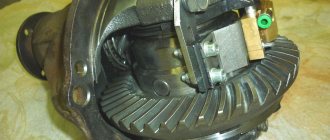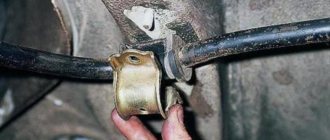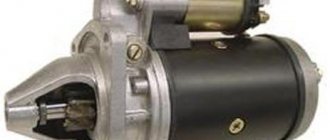Differential locking is an additional design solution that allows you to compensate for its main disadvantages. If on a dry, flat road the differential provides safe maneuvering and comfort, then when driving on rough terrain or while driving on a slippery road surface, it can completely deprive the car of the ability to move. To prevent this from happening, it is necessary to limit the functionality of the node or completely disable it for a while. But differential locking methods are so diverse that we need to consider the main ones separately.
What is a differential?
In short, this is an element (mechanism) directly connected to the wheel axles, the main task of which is to transmit torque to them. This transmission of torque is possible thanks to the use of the so-called “planetary mechanism”.
Another, no less important task performed by the differential is to ensure the possibility of asynchronous rotation of the drive wheels when the vehicle turns or when passing through uneven and difficult terrain.
diff
On slippery roads, driving a car with a locked differential is more difficult; the driver requires good racing training.
On slippery roads, driving a car with a locked differential is more difficult; the driver requires good racing training.
During intense acceleration and, to a lesser extent, during steady motion, the Kalina reacts more sensitively to uneven road surfaces: it becomes nervous, it is pulled towards looser surfaces, and it has to work harder with the steering wheel. A dynamic corridor of about a meter and a half requires greater concentration and precision from the driver. On a long journey, you begin to fondly remember the more comfortable factory version.
What is a differential lock?
Before we talk about this, let's look at how the classic type differential works.
And so .. A classic (standard) differential, or as it is also called an “open differential,” transfers power from the engine to the axle, which allows the wheels to rotate at different speeds while the car turns.
Since the distance each wheel must travel when turning is different (one wheel has a larger outer turning radius than the other wheel, which has a shorter inner radius), a differential solves this problem by transmitting torque on the separate axles of the two wheels through its mechanism. The end result is that the car can drive and turn normally.
Unfortunately, this particular mechanism has some disadvantages. It seeks to transfer torque where it is easiest.
Advantages and disadvantages of a limited slip differential
A self-locking differential is a device that transforms torque from the “engine” to the wheels using transmission elements. An alternative option is forced blocking.
Many drivers are interested in which self-locking differential should be installed on a Russian-made SUV. Experts say you need to pay attention to a mechanical, pneumatic or electronic self-block.
The advantages of a limited-slip differential include:
1. The car gets the opportunity to move freely over bad terrain.
2. The design of the car remains unchanged, since the self-block is installed in the area of the standard part.
3. The mechanism operates automatically; you do not need to have special skills to operate it.
The disadvantages of installing a self-locking element include the fact that vehicle control becomes worse. The driver will have to make an effort to steer. The working life of this element is less than the factory one. Driving style changes when cornering, but there is no 100% guarantee of blocking.
What does it mean?
If both wheels on an axle have the same traction and the force required to turn each wheel, an open differential will distribute torque evenly between them. However, if there is a difference in traction (for example, one wheel is on the asphalt and the other is in a hole or on ice), the differential will begin to distribute torque to the wheel that will rotate with the least effort (deliver more torque to the wheel that is caught on the road). ice or into a hole).










